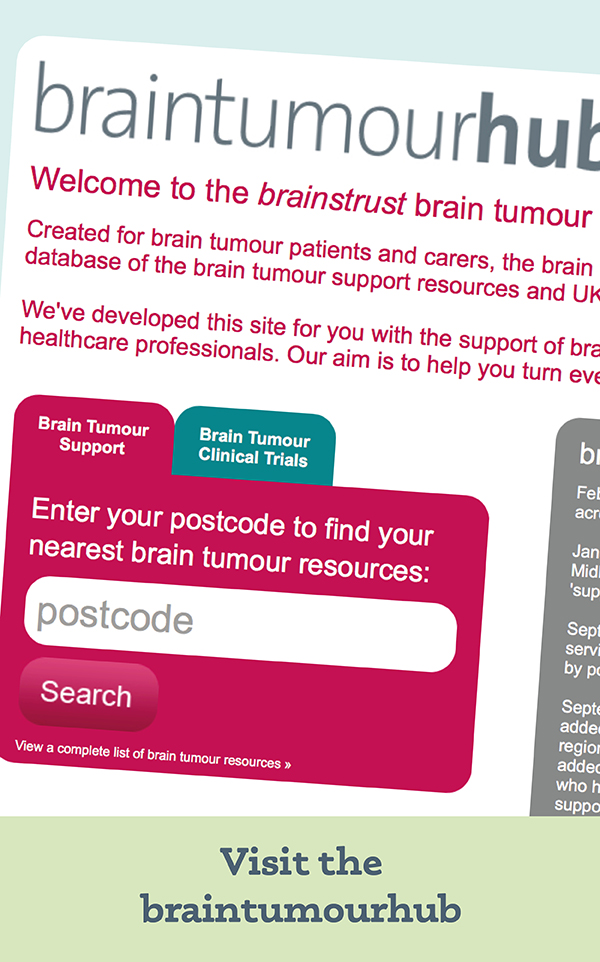Working effectively with your team
Knowledge is power: key questions to ask your doctors
I feel I have a far better idea of what to ask my consultant when I next see him and what the long term implications will be. This has given me more sense of not only an understanding of my situation, but I feel like I have regained some control of the situation and my life again.
Nadia, patient, London.
Who and what to ask
Our Who’s Who guide will help you get a sense of the roles of the different healthcare professionals in your clinical team.
It is essential to know about the type of tumour and also whereabouts it is in the brain, as this will provide information about the type of symptoms that could be experienced. If possible seek the answers to these key questions as soon as you can:
- What is the tumour type?
- What is the grade?
- Where is it?
- How will its position impact on me?
And of course, the more you know, the more in control you will feel as you will be able to make informed decisions about which direction you should take whilst navigating your way around.
See our Patient Guides to help you focus on key questions.

One note about managing expectations. Your doctor does not always have the answers. They want to do the best they can for you but sometimes they too are frustrated that options can be limited. Accept this and consultations become more open as you explore options.
But we know too how difficult it is staying focused in such an emotional situation. There are things you can do that might help you to have better, more focused conversations, one of which is simply planning the conversation. The vast majority of people say it is important to communicate their wishes when ill, but only some people put this into practice. Planning and rehearsing what you’d like to get out of a conversation can make it infinitely more valuable.
Second opinions can be invaluable for serious diagnoses. Find out how brainstrust can help you seek a second opinion.
Being ready
Explore in your own mind:
- Why do you want to have the conversation? What is important to you in doing this?
- Why now?
- What do you need to say?
- What do you believe the other person needs to hear?
- What do you need to be ready to have the conversation?
- How can you resource yourself?
- Where should you have the conversation? What is important about the environment?
Doing it well
There are four stages of awareness that shift the scope of a conversation from individual reflection to shared insight:
- Concrete information – the facts
- The emotive responses – the feelings
- Their interpretation – where the deep grappling is done to find the meaning
- The decision – where implications and decisions are discussed.
1. Concrete information – the facts
| Focus of the questions | The facts about the brain tumour – the medical and the situation (the external reality, which your consultant won’t know. For example, you are the patient and also the main caregiver for two small children). |
| What it does for you both | Ensures that everyone deals with the same body of data and all of the aspects |
| Questions are in relation to: | The senses: what is seen, heard and touched |
| Key questions | What do I hear? What words or phrases stand out? What happened – use summary to recap what you think you heard to establish the facts. |
2. The emotive responses – the feelings
| Focus of the questions | Internal relationship to the brain tumour |
| What it does for you both | Reveals internal responses |
| Questions are in relation to: | Feelings, moods, emotional tones, memories or associations |
| Key questions | What do you spend time thinking about? How does it make you feel? Where and when have you struggled? |
3. The interpretation – where the deep grappling is done to find the meaning. The interpretative responses build on the facts, plus associations or feelings from the reflective level.
| Focus of the questions | The meaning of it all |
| What it does for you both | Draws out the significance from the facts for you both |
| Questions are in relation to: | Layers of meaning, purpose, significance, implications and values. Considering alternatives, options and the plan. |
| Key questions | What is happening here? What is this all about? What does it mean for us? How does this affect us? What are our insights from this? |
4. The decision – where implications and decisions are discussed. Here some kind of resolve brings the conversation to a close. The questions allow for conscious choices to be made.
| Focus of the questions | Resolution, implications, new directions |
| What it does for you | Makes the conversation relevant for what you want in the future |
| Questions are in relation to: | Clarity, planning and action |
| Key questions | What therefore do we want? What decision is called for? What are the next steps? |






